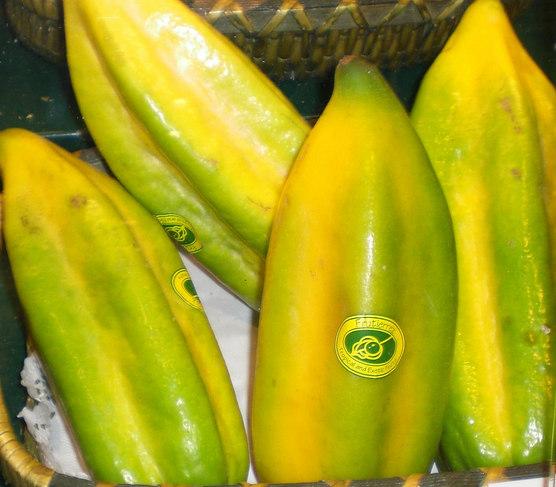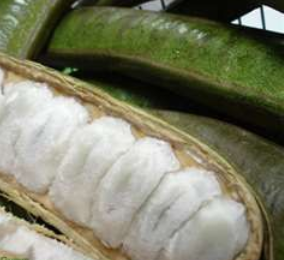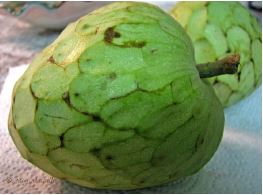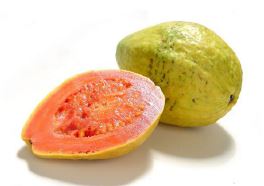A shopper’s guide to the strange fruits of Ecuador
When you visit the tiendas, mercados, and supermercados of Cuenca for the first time you’ll find a number of fruits that are familiar to North Americans and, for the most part, people all over the world. On the other hand, you’ll discover fruit you’ve never seen before, many of bizarre-looking that could straight out the pages of a Dr. Seuss story book.
 The exotic and uncommon fruits are, naturally, of more interest to the curious and culinarily adventurous expats. The following are the descriptions, and photos of many of the fruits that will be new to visitors and newcomers.
The exotic and uncommon fruits are, naturally, of more interest to the curious and culinarily adventurous expats. The following are the descriptions, and photos of many of the fruits that will be new to visitors and newcomers.
Babaco (bah-BAH-ko)
A torpedo-shaped fruit that’s bright yellow when ripe. It’s milky-colored and effervescent on the inside, hence its other name: champagne fruit. The flesh is 99% water and is slighty tart, but exotic and delicious. It’s often made into a juice.
A green softball-size fruit, with a sweet white pulp and big black seeds (spit them out). It’s also known as custard apple.
Granadilla (grah-nah-DEE-yah)
 Very similar to the maracuyá (passion fruit; see below) in its roundish shape, palm size, yellow color, and consistency of juice, pulp, and seeds. But unlike maracuyá, the skin is smooth and the taste is very sweet. To eat it, you slice off the top or cut it in half and scoop out the goo.
Very similar to the maracuyá (passion fruit; see below) in its roundish shape, palm size, yellow color, and consistency of juice, pulp, and seeds. But unlike maracuyá, the skin is smooth and the taste is very sweet. To eat it, you slice off the top or cut it in half and scoop out the goo.
Guanábana (wah-NAH-bah-nah)
A larger version of a chirimoya, called soursop in English, this fruit is the size of a small melon, with white fleshy pulp and black seeds. It’s used for juice, ice cream, and pie, but rarely eaten raw.
Guava (WAH-vah)
Not the guava that North Americans are familiar with, the Ecuadorian guava is a pod-like fruit with a cotton-like pulp (the part you eat) and dark seeds (the part you don’t).
This is the English-language guava, a round yellow fruit with a tartish pinkish-yellow flesh. It’s mostly used as a mermelada.
Maracuyá (mah-rah-coo-YAH)
 Better known as passion fruit, due to how, like granadilla and tomate de árbol (see below), you bite off the end, squeeze, and suck out all the luscious sexy juice, pulp, and seeds. It’s a bright yellow fruit with a slightly mottled skin that becomes rougher and more wrinkled as it gets overripe; very tart tasting, it makes a fabulous juice, with added sugar.
Better known as passion fruit, due to how, like granadilla and tomate de árbol (see below), you bite off the end, squeeze, and suck out all the luscious sexy juice, pulp, and seeds. It’s a bright yellow fruit with a slightly mottled skin that becomes rougher and more wrinkled as it gets overripe; very tart tasting, it makes a fabulous juice, with added sugar.
An Andean variety of blackberry, usually served as a juice, but also made into jelly and mermelada. Moras are similar to black berries in North America and Europe.
Naranjilla (nah-rahn-HEE-yah)
 A small round fruit, closely related to the tomato (the plant itself resembles an eggplant, and thanks to Jeannie McGinnis of cuencafoodie.com for the detail) with green transparent flesh and small seeds. It’s not eaten raw; rather, it’s used for juice and ice cream. Don’t confuse naranjilla with naranja (orange).
A small round fruit, closely related to the tomato (the plant itself resembles an eggplant, and thanks to Jeannie McGinnis of cuencafoodie.com for the detail) with green transparent flesh and small seeds. It’s not eaten raw; rather, it’s used for juice and ice cream. Don’t confuse naranjilla with naranja (orange).
A member of the dragon-fruit family, which is usually red in color, the Ecuadorian variety is yellow. It has an off-white pulp with tiny black seeds and is very sweet. Though watery, it’s too expensive (between $5 and $7 a kilo, Ecuador’s most expensive fruit by far) to be made into a juice. To eat, you cut off the top, then clean it out with a spoon. And you will clean out every last bite of it; it’s that good (and expensive). Like papaya, pitajaya is believed to aid digestion.
Tomate de árbol (toh-MAH-tey dey AR-bowl)
 An oblong yellow, orange, or red fruit. Like granadillas and maracuyás, you eat it either by cutting it in half and scooping the pulp, seeds, and juice with a spoon, or biting off the end, squeezing, and sucking it all out. You can consume them plain; they’re also used in juices and desserts. It has no relation to bush or vine tomatoes (tomates).
An oblong yellow, orange, or red fruit. Like granadillas and maracuyás, you eat it either by cutting it in half and scooping the pulp, seeds, and juice with a spoon, or biting off the end, squeezing, and sucking it all out. You can consume them plain; they’re also used in juices and desserts. It has no relation to bush or vine tomatoes (tomates).
Prickly pear, a cactus-like fruit with a sweet red flesh. (The Spanish word for tuna fish is atún.)
Uvilla (oo-VEE-yah)
 Also known as the gooseberry, this is a tart, berry-like, yellow-orange fruit about the size of a small grape (the word for grape is uva).
Also known as the gooseberry, this is a tart, berry-like, yellow-orange fruit about the size of a small grape (the word for grape is uva).























